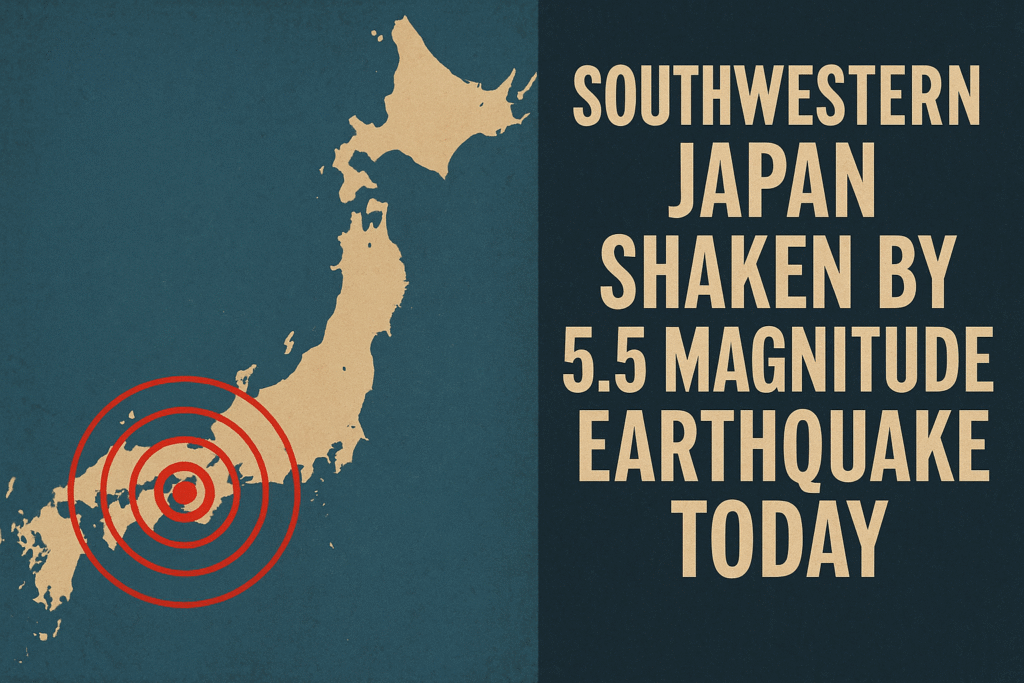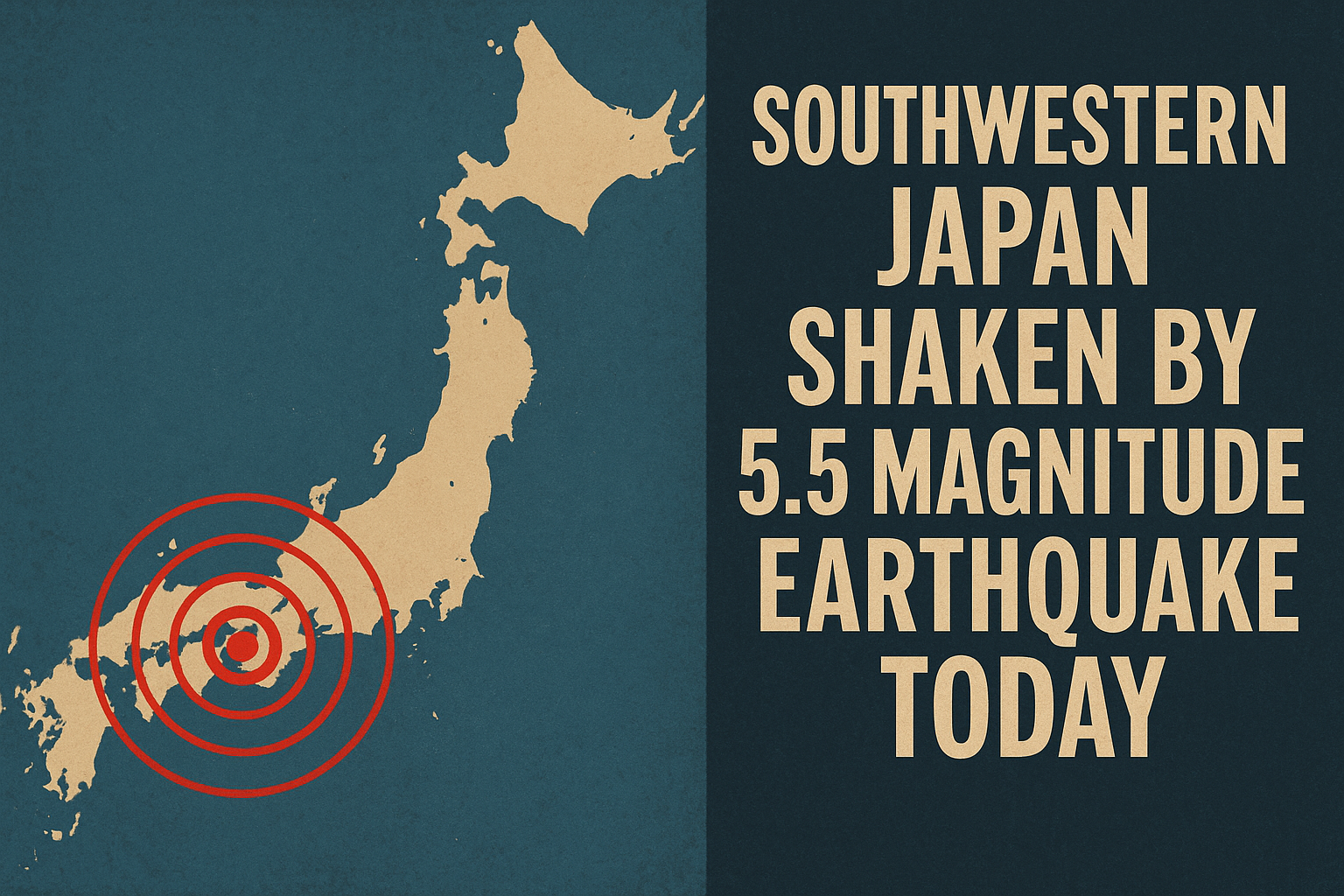Southwestern Japan Shaken by 5.5
In a significant seismic event, Southwestern Japan Shaken by 5.5 Magnitude Earthquake on Thursday, sending ripples of concern across the region. According to the Japan Meteorological Agency (JMA), the earthquake struck off the coast of the Tokara island chain in Kagoshima prefecture, approximately 1,200 kilometers away from the capital city of Tokyo. Though the tremors were moderately strong, authorities confirmed that no tsunami warning had been issued following the incident.
The news that Southwestern Japan Shaken by 5.5 Magnitude Earthquake spread rapidly, with local residents and national agencies on high alert. The JMA reported that the seismic activity’s epicenter was located offshore near the Tokara islands, a sparsely populated area known for frequent minor quakes. However, the intensity of this tremor was notably higher than usual.
The Japan Meteorological Agency further noted that a seismic intensity of ‘6 lower’ on Japan’s stringent 1-7 seismic scale was observed at Akuseki Island. This level of intensity signifies strong shaking, potentially causing minor structural damage and triggering landslides in vulnerable areas. The report confirming Southwestern Japan Shaken by 5.5 Magnitude Earthquake was followed by precautionary inspections of infrastructure, public buildings, and transportation lines.
As is customary in Japan — a nation highly familiar with seismic activity — residents in nearby areas reported feeling prolonged tremors, though no significant injuries or damages were immediately reported. Emergency services and disaster response teams were promptly mobilized in anticipation of possible aftershocks.
Experts explained that Southwestern Japan Shaken by 5.5 Magnitude Earthquake is part of ongoing tectonic activity along the Pacific Ring of Fire, a region notorious for frequent seismic events. The Tokara island chain, lying near several major fault lines, routinely experiences moderate tremors, though quakes of this magnitude are relatively infrequent.
The JMA assured the public that while the Southwestern Japan Shaken by 5.5 Magnitude Earthquake was felt over a wide area, the absence of a tsunami alert minimized the immediate risk to coastal communities. Authorities urged residents to remain cautious and stay updated through official information channels, as aftershocks are common in the hours and days following a quake of this strength.
Seismologist Dr. Keiji Tanaka stated, “When Southwestern Japan Shaken by 5.5 Magnitude Earthquake, it underscores the region’s inherent vulnerability to tectonic shifts. The Tokara islands lie in a geologically active zone, and such incidents serve as reminders of the importance of preparedness.” Dr. Tanaka also emphasized that while this event did not result in casualties, continuous monitoring and early warning systems remain crucial.
The Southwestern Japan Shaken by 5.5 Magnitude Earthquake also prompted Japan Railways (JR) to temporarily suspend services in parts of Kagoshima and neighboring prefectures for safety checks. Operations resumed after confirming no damage to tracks or facilities. Airports in the region conducted rapid inspections of runways and terminals, ensuring passenger safety and operational integrity.
Japan’s resilience to earthquakes is attributed to its strict building codes and extensive disaster management systems. Every time Southwestern Japan Shaken by 5.5 Magnitude Earthquake, it triggers a well-coordinated response from municipal authorities, emergency services, and community organizations.
The incident gained international attention, with news outlets reporting on Southwestern Japan Shaken by 5.5 Magnitude Earthquake as a testament to the ever-present seismic risks in East Asia. The United States Geological Survey (USGS) also recorded the quake, confirming its magnitude and location.
In schools and public institutions across Kagoshima prefecture, earthquake drills that had recently been conducted proved effective, with students and staff swiftly adhering to safety protocols. Residents on Akuseki Island, closest to the epicenter, described the quake as sudden and forceful, lasting several seconds but causing no visible damage.
Tourism officials in the Tokara islands, where Southwestern Japan Shaken by 5.5 Magnitude Earthquake, reported no injuries among visitors. However, certain outdoor activities and boat services were temporarily suspended pending safety evaluations.
The regional government announced plans for a thorough assessment of older buildings and infrastructure. The incident where Southwestern Japan Shaken by 5.5 Magnitude Earthquake highlights the importance of seismic reinforcements, especially in structures predating modern earthquake-resistant construction codes.
Social media platforms lit up with real-time updates and firsthand accounts as users posted videos and images capturing the tremors. Hashtags like #JapanEarthquake and #SouthwesternJapan trended globally as news of Southwestern Japan Shaken by 5.5 Magnitude Earthquake reached international audiences.
Japan’s Prime Minister Fumio Kishida was briefed on the situation immediately after reports of Southwestern Japan Shaken by 5.5 Magnitude Earthquake emerged. Kishida expressed relief that there were no reports of casualties or significant damage, and commended emergency services for their rapid response.
In recent years, Japan has heavily invested in enhancing its earthquake monitoring systems and emergency response frameworks. Each occurrence where Southwestern Japan Shaken by 5.5 Magnitude Earthquake serves as a practical test for these systems, reaffirming the nation’s readiness for seismic threats.
Looking ahead, authorities emphasized vigilance as aftershocks remain a possibility. The JMA advised residents to stay prepared, check emergency kits, and follow official instructions. Despite the relative calm following the event, officials continue to monitor seismic activity in the region closely.
The incident of Southwestern Japan Shaken by 5.5 Magnitude Earthquake serves as a sobering reminder of the persistent seismic hazards Japan faces. Yet it also underscores the effectiveness of Japan’s disaster preparedness infrastructure. From early warning systems to community awareness programs, the country’s proactive measures played a key role in ensuring public safety.
As recovery and inspections proceed, Japan remains a model for earthquake readiness globally. The lessons learned each time Southwestern Japan Shaken by 5.5 Magnitude Earthquake contribute to further refining emergency procedures and infrastructural resilience.
In conclusion, while the occurrence where Southwestern Japan Shaken by 5.5 Magnitude Earthquake raised concerns, the absence of a tsunami alert and significant damage attests to the country’s preparedness. Continuous investment in seismic research, public education, and rapid response systems ensures that Japan remains vigilant and resilient in the face of natural disasters.


2 thoughts on “Southwestern Japan Shaken by 5.5 Magnitude Earthquake Today”
Comments are closed.